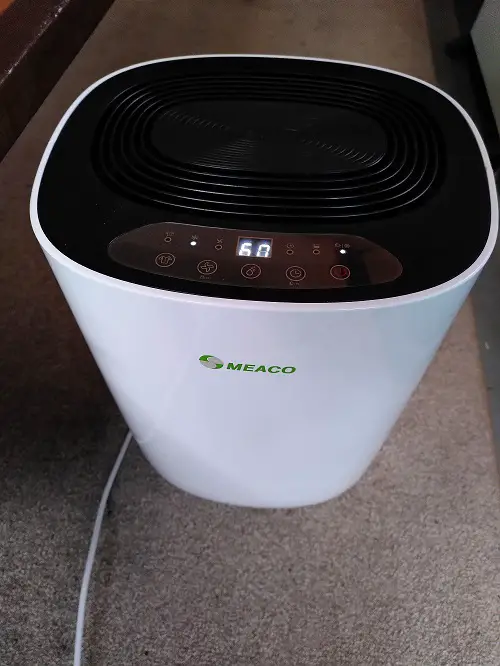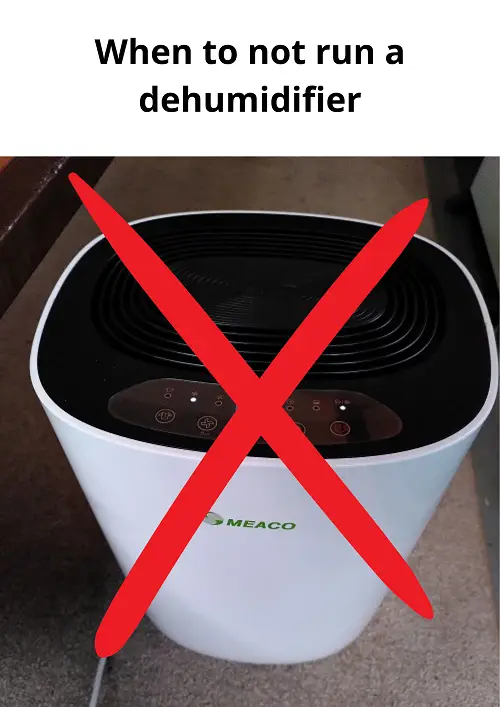
Dehumidifiers are excellent for lowering humidity and improving thermal comfort. However, there are a few reasons why you might not want to run one.
Before you turn on your dehumidifier or decide whether to purchase one, make sure you know when not to use it.
The reasons for not running your dehumidifier are:
- Low temperatures can cause freezing damage
- Open windows make a dehumidifier useless
- Clean filters before running the device
- Air circulation from its fan reduces air quality
- Don’t run one when the air is already dry
Low temperatures can cause freezing damage
Dehumidifiers come in two types, compressor or desiccant. The compressor type is the most common. Compressor dehumidifiers work best at temperatures above 60 °F (15 °C) and high relative humidity (65% RH and higher).
However, at temperatures below 60 °F (15 °C), they run the risk of freezing their internal parts. Therefore, you should not run your compressor dehumidifier at low temperatures.
Some compressor dehumidifiers, however, do have a function that makes them stop running and start a defrosting process. Therefore, some of them can still be used when the temperature is around the limit of 60 °F (15 °C).
For more information about compressor and desiccant dehumidifiers, I recommend reading my article: How does a dehumidifier work?
Open windows counteract dehumidification
A dehumidifier can only effectively lower humidity when the air is not being refreshed. If the room is heavily ventilated, for example when one or more windows are open, a dehumidifier is useless.
Since ventilation allows for outdoor air to enter the building, the indoor air that has been dehumidified will be exchanged for outdoor air. Therefore, the humidity in the room will not go down.
If you need to ventilate, shut down the dehumidifier. Turn it back on when you have closed all windows.

Clogged dehumidifier filters
Dehumidifiers come with a filter for the incoming air. This filter prevents dust particles from entering the device, keeping it clean and preventing the recirculation of dust.
However, these filters slowly accumulate dust until they are no longer able to let the air through. When this is the case, stop running the device and clean or replace the filter.
You can easily check whether the filter is clogged by opening the filter opening on the device and looking at the dust buildup.
Air circulation harms air quality
Although dehumidifiers do an excellent job of improving air quality, they do this only in one or two aspects. Dehumidifiers improve air quality by:
- Optimizing humidity levels
- Reducing airborne dust
For in-depth information about every air quality benefit of dehumidifiers, I recommend reading my article: Can a dehumidifier improve indoor air quality?
However, there is one air quality issue with using a dehumidifier. It circulated the air in a closed-off room.
Circulating the air means that any dust particle that has settled on a surface will become airborne again. This means anyone in the room can breathe in these particles.
Normally, in well-ventilated rooms, air circulation is not much of an issue. It can even aid ventilation. However, a dehumidifier requires a closed-off room to function optimally. Therefore all the air in the room is not being refreshed. this means that every particle of dust that is in the air stays there, gets recirculated, and is a potential hazard for our lungs.
As stated above, the filter on a dehumidifier helps remove dust particles from the air. However, this takes a while. Also, by circulating the air, it first reintroduces dust that was settled down.
So, before running a dehumidifier in a room that hasn’t been dusted in a while, make sure to clean the room.
Don’t make the air too dry
Sometimes, lowering the relative humidity is not desirable. Of course, this is the case when the optimal humidity is already reached. At that point, you can shut down the device, let it run on its slowest mode, or use the built-in humidistat to maintain the desired humidity.
However, there are other cases in which lowering humidity is not desirable:
- When the room always had high humidity and contains wooden furniture
- When someone’s health requires higher humidity
Preventing furniture damage by a dehumidifier
Wooden furniture is sensitive to humidity. the wood absorbs moisture and expands or shrinks depending on the amount of air moisture. Therefore, when wooden furniture has been in a room with high humidity for a long time, it can be damaging to lower it.
If the air suddenly dries out, the wooden furniture will rapidly lose its moisture to the air. This can lead to cracks in the wood, causing permanent damage. This is especially an issue in small rooms that have had high air humidity for a long time (many years).
If you need to dehumidify the air, try to gradually and slowly lower the air moisture. Use a small dehumidifier for the room, or run your device on the slowest option.
Some lung conditions worsen in dry air
A dehumidifier generally makes sure humidity levels will reach more comfortable levels. However, for people with lung conditions, these levels can be different. These people can be very sensitive to certain humidity levels. (source)
Therefore, you need to be careful with drastic humidity changes. Make sure to contact an expert on their specific condition and the most comfortable relative humidity for that person.
Would you like some help in deciding which dehumidifier to buy? I wrote an article about which features are helpful and which ones you don’t need:


